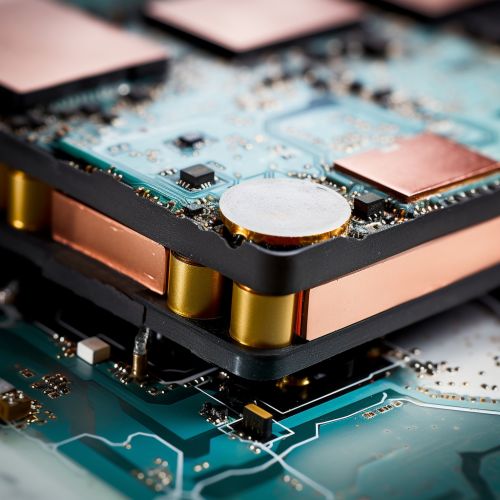Solid-state battery
Introduction
Solid-state batteries are a type of battery that uses solid electrodes and a solid electrolyte, instead of the liquid or polymer gel electrolytes found in lithium-ion or lithium polymer batteries. These batteries have the potential to provide high energy and power densities, long life cycles, and high safety levels compared to traditional batteries.
History
The concept of solid-state batteries has been around since the 19th century, but it wasn't until the 1950s that the first practical solid-state battery was developed. This early version used silver sulfide as the electrolyte and was primarily used in pacemakers due to its long life and reliability.
Structure and Composition
Solid-state batteries are composed of three main components: the anode, the cathode, and the electrolyte. The anode and cathode are typically made of lithium, while the electrolyte is a solid material that allows for the movement of ions.
Anode
The anode of a solid-state battery is typically made of lithium metal. This is because lithium has a high electrochemical potential, which allows for a high energy density.
Cathode
The cathode in a solid-state battery is typically a lithium metal oxide. This material is chosen for its high energy density and stability.
Electrolyte
The electrolyte in a solid-state battery is a solid material that allows for the movement of ions. This material can be a ceramic, glass, or a solid polymer. The choice of electrolyte material is crucial as it needs to be highly conductive to ions, but not to electrons, to prevent self-discharge.


Advantages and Disadvantages
There are several advantages and disadvantages to using solid-state batteries compared to traditional batteries.
Advantages
Solid-state batteries have a number of advantages over traditional batteries. These include a higher energy density, longer life cycle, and improved safety. The solid electrolyte in these batteries is non-flammable, reducing the risk of battery fires. Additionally, solid-state batteries can operate at higher temperatures, making them suitable for a wider range of applications.
Disadvantages
Despite their advantages, solid-state batteries also have some disadvantages. These include higher manufacturing costs and challenges with ion transport in the solid electrolyte. Additionally, the solid electrolyte can lead to the formation of dendrites, which can cause short circuits and reduce the life of the battery.
Applications
Solid-state batteries have a wide range of potential applications. These include electric vehicles, portable electronics, and grid storage.
Electric Vehicles
One of the most promising applications for solid-state batteries is in electric vehicles. The high energy density and safety of these batteries make them an attractive option for this application.
Portable Electronics
Solid-state batteries could also be used in portable electronics, such as smartphones and laptops. The high energy density of these batteries could potentially lead to longer battery life for these devices.
Grid Storage
Solid-state batteries could also be used for grid storage. The long life cycle and high energy density of these batteries make them suitable for this application.
Future Developments
Research and development into solid-state batteries is ongoing, with the aim of overcoming the current limitations and making these batteries more commercially viable. This includes research into new materials for the electrolyte, as well as methods to prevent dendrite formation.
